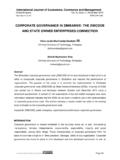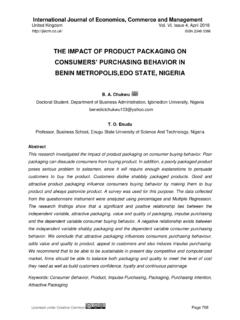Transcription of SAMPLING TECHNIQUES & DETERMINATION OF SAMPLE …
1 International Journal of Economics, Commerce and Management United Kingdom Vol. II, Issue 11, Nov 2014. ISSN 2348 0386. SAMPLING TECHNIQUES & DETERMINATION OF SAMPLE . size IN applied statistics RESEARCH: AN OVERVIEW. Singh, Ajay S. Department of AEM, Faculty of Agriculture, University of Swaziland, Luyengo, Swaziland Masuku, Micah B. Department of AEM, Faculty of Agriculture, University of Swaziland, Luyengo, Swaziland Abstract applied statistics research plays pivotal role in diverse problems of social sciences, agricultural sciences, health sciences, and business research.
2 Many investigations are conducted by survey research. The technique of SAMPLING and DETERMINATION of SAMPLE size have crucial role in survey-based research problems in applied statistics . Specific SAMPLING TECHNIQUES are used for specific research problems because one technique may not be appropriate for all problems. Similarly, if the SAMPLE size is inappropriate it may lead to erroneous conclusions. The present paper gives an overview of some commonly used terms and TECHNIQUES such as SAMPLE , random SAMPLING , stratified random SAMPLING , power of the test, confidence interval that need to be specified for a SAMPLE size calculation and some TECHNIQUES for DETERMINATION of SAMPLE size , and also describes some SAMPLING methods such as purposive random SAMPLING , random SAMPLING , stratified random SAMPLING , systematic random SAMPLING and quota SAMPLING for specific research purposes.
3 Keywords: SAMPLING , SAMPLE size , Power of the Test, Confidence Interval, Level of Significance Licensed under Creative Common Page 1. Singh & Masuku INTRODUCTION. statistics are used to summarize the data collected through survey or investigation. The basic role of statistics in research is to make conclusions about a population of interest when data is only available from a SAMPLE . Research data usually measure observations of an occurrence of an event as well as indicate exposure. Also, the role of statistician is to determine whether any association that is observed in the SAMPLE is actually a real one.
4 In most cases, there will be some association even though very small. The statistician also have important role in determining if the association is different than what would occur by chance. The most common and basic statistical method used in applied research is frequency measure, which is simply a measure of counting and comparing their characteristics. These frequency measures are rates, ratios and proportions. The SAMPLING TECHNIQUES , on the other hand, are commonly used for research investigations to better estimate at low cost and less time with greater precision.
5 The selection of SAMPLING methods and DETERMINATION of SAMPLE size are extremely important in applied statistics research problems to draw correct conclusions. If the SAMPLE size is too small, even a well conducted study may fail to detect important effects or associations, or may estimate those impacts or associations too imprecisely. Similarly, if the SAMPLE size is too large, the study would be more complex and may even lead to inaccuracy in results. Moreover, taking a too large SAMPLE size would also escalate the cost of study.
6 Therefore, the SAMPLE size is an essential factor of any scientific research. Sathian (2010) has pointed out that SAMPLE size DETERMINATION is a difficult process to handle and requires the collaboration of a specialist who has good scientific knowledge in the art and practice of medical statistics . TECHNIQUES for estimating SAMPLE size and performing power analysis depend mainly on the design of the study and the main measure of the study. There are distinct methods for calculating SAMPLE size for different study designs and different outcome measures.
7 Additionally, there are also some different procedures for calculating the SAMPLE size for two approaches of drawing statistical inference from the study results on the basis of confidence interval approach and test of significance approach. With mushroom growth of journals in recent years the number of publications in survey-based investigations has gone considerably high. Many of the studies, however, lack in selection of the appropriate SAMPLING methodology. It was therefore considered pertinent to give single source information about the SAMPLING and SAMPLE size DETERMINATION to the readers.
8 The present paper, thus, gives an overview of some commonly used terms and TECHNIQUES that need to be specified for a SAMPLE size calculation and some TECHNIQUES for DETERMINATION of SAMPLE size , and also describes some SAMPLING methods for specific research purposes. Licensed under Creative Common Page 2. International Journal of Economics, Commerce and Management, United Kingdom SAMPLING . SAMPLING is an old concept, mentioned several times in the Bible. In 1786, Pierre Simon Laplace estimated the population of France by using a SAMPLE technique, along with ratio estimator.
9 He also computed probabilistic estimates of the error. Alexander Ivanovich Chuprov introduced SAMPLE surveys to Imperial Russia in the 1870s (Cochran 1963 and Robert et al. 2004). SAMPLING is related with the selection of a subset of individuals from within a population to estimate the characteristics of whole population. The two main advantages of SAMPLING are the faster data collection and lower cost. (Kish 1965, Robert 2004)Each observation measures one or more properties of observable subjects distinguished as independent individuals.
10 In business research, medical research, agriculture research, SAMPLING is widely used for gathering information about a population. SAMPLING TECHNIQUES The method for the selection of individuals on which information are to be made has been described in literature (Kish 1965, Gupta and Kapoor 1970). The following points need to be considered in selection of individuals. a. Investigations may be carried out on an entire group or a representative taken out from the group. b. Whenever a SAMPLE is selected it should be a random SAMPLE .










